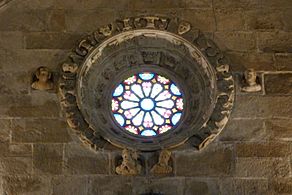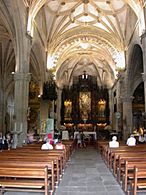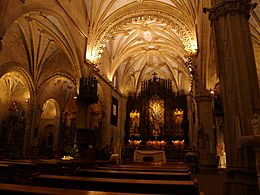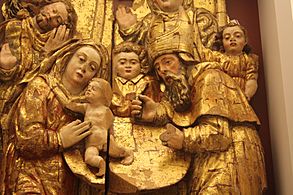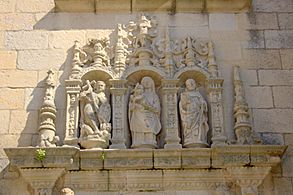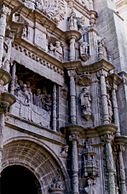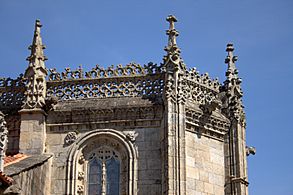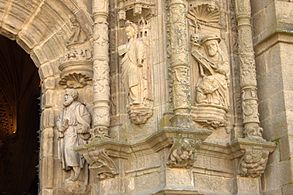Basilica of Saint Mary Major (Pontevedra) facts for kids
Quick facts for kids Basilica of Saint Mary Major |
|
|---|---|
|
Basílica de Santa María a Maior de Pontevedra
|
|

The Western façade of the basilica.
|
|
| Religion | |
| Affiliation | Catholic |
| Location | |
| Location | Pontevedra, Galicia, Spain |
| Architecture | |
| Architectural type | Basilica |
| Architectural style | Gothic, Renaissance |
| Completed | 1559 |
| Direction of façade | West |
| Official name: Basílica de Santa María la Mayor | |
| Designated | 3 June 1931 |
| (R.I.) - 51 - 0000828 - 00000 | |
The Basilica of Saint Mary Major is a beautiful old Catholic church located in Pontevedra, Spain. It was built in the 16th century, which means it's over 400 years old! On January 10, 1962, it was given the special title of "basilica" by Pope John XXIII.
Today, this church is considered a very important historical and artistic building in Spain. It's officially recognized as a "Good of Cultural Interest" (or BIC for short) and was declared a national treasure in 1931.
Contents
A Look Back: The Basilica's Story
The Basilica of Saint Mary Major is the most important church in Pontevedra. It acts like a main cathedral for the city. You can find it in the old part of Pontevedra, in a place called Alonso de Fonseca square. Before this grand basilica, a smaller, older church stood in the same spot, but it was taken down in the 1400s.
The building of this basilica was a big project. It was paid for by the Guild of Seamen. This was a very old group of sailors and fishermen in Pontevedra. They were the oldest group of their kind in all of Spain! Many talented people helped design and build the church, including Juan de los Cuetos and Diego Gil. Other artists like Cornielis de Holanda and Juan Noble also worked on it.
What Does the Basilica Look Like?
The Basilica of Saint Mary Major is built in a style called Gothic. It also has some influences from a Portuguese style known as Manueline.
The Outside of the Church
The outside of the church is very impressive, especially its main front, which faces west. You walk up a wide staircase to reach it. This front part looks like a giant, decorated altarpiece, which is a large artwork often found behind an altar. It has three sections filled with lots of detailed carvings, made in a style called Plateresque. These carvings were finished in 1541 by Cornielis de Holanda and Juan Noble.
The main door is in the middle section. It's a rounded arch with sculptures of Saint Peter and Saint Paul on either side. Above the door, you can see a carved picture, called a relief, showing the Dormition of Mary. This means Mary falling asleep before going to heaven. Higher up, there are decorations shaped like scallop shells and sculptures of saints, people from the Bible, and even historical figures.
Even higher, there's a large round window called a rose window. This window lets light into the church and is meant to represent heaven. The very top of the front has a calvary, which is a scene showing Jesus on the cross, and special stone carvings typical of the Portuguese Manueline style. Look closely, and you might spot busts (head and shoulders sculptures) of famous explorers like Christopher Columbus and Hernán Cortés near the rose window!
There's also another important entrance on the south side of the building. It has a rounded arch and more Manueline stone carvings along the top of the walls and around the back part of the church, called the apse. The apse also has a large, decorated window in the Manueline style.
Inside the Church
When you go inside, you'll see that the church has a basilica plan. This means it has a long central area called a nave and two smaller aisles on either side. The central aisle mostly shows the Renaissance style, which was popular after the Gothic period. The side aisles and the smaller rooms, called chapels, have a late Gothic style.
The basilica has many different chapels, each with its own special purpose. Some of these include the larger chapel, the chapel of Christ, the chapel of the Angustias, the chapel of the Purísima, the chapel of the Trinity, and the altar of the Sorrowful Virgin.
Gallery
See also
 In Spanish: Basílica de Santa María la Mayor (Pontevedra) para niños
In Spanish: Basílica de Santa María la Mayor (Pontevedra) para niños


